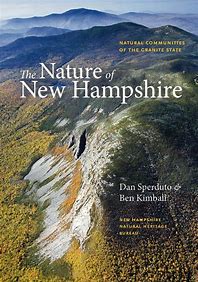Ecological Systems
Information about what ecological systems are, and how and why they are classified and ranked.
What are Ecological Systems?
Ecological systems are associations of natural communities that repeatedly co-occur in the landscape and are linked by a common set of driving forces, including landscape setting, environmental features (e.g., hydrology, soil, and nutrients), and ecological dynamics (e.g., fire and flooding). Ecological systems form cohesive and distinguishable units on the ground and recur in similar settings.
Forty-five (45) Ecological systems are described for New Hampshire. Diagnostic characteristics of each system include component natural communities, physical structure, ecological conditions, and geographic distribution.
What Are Exemplary Ecological Systems?
The Natural Heritage Bureau gives conservation priority to "exemplary" ecological systems. Systems earn this distinction one of two ways:
The system type is so rare that all examples are considered exemplary.
OR
Excellent examples of common ecological system types.
These exceptional conditions are desirable because they are likely to support the greatest variety of native species and the ecological processes on which they depend. Exemplary ecological systems represent many of the best remaining examples of New Hampshire flora, fauna, and underlying ecological processes.
The Bureau identifies and documents these exemplary systems to track their condition and inform the public of their conservation value.
How Are Ecological Systems Classified?
System descriptions explain how natural communities are linked into larger units in the landscape, providing us with an understanding of natural community patterns at a different scale.
For instance, there are five natural communities that are often found together on peaks above 4,900 ft. elevation in New Hampshire. Each individual community corresponds to a particular combination of exposure, substrate, wetness, and snow depth, but all five share the predominant influence of an extreme climate and short growing season. Collectively, these individual communities form a larger alpine tundra system”.
Why Do We Classify Ecological Systems?
While natural communities are the primary units for understanding ecological patterns on the New Hampshire landscape, they can sometimes be difficult to use for conservation planning. Some community types occur as very small patches and many types occur in complex mosaics.
In contrast, ecological systems may be a more appropriate level of vegetation classification for users that have relatively little experience with plants. When using the broad classes of communities and systems, such as floodplain forests, talus slopes, and rocky ridges, one can begin to grasp the diversity of landscape types that strongly influence vegetation.
Some of the major benefits of classifying ecological systems include:
- They are at an appropriate scale for many conservation applications such as ecological integrity assessments (EIA Manual), mapping and predictive modeling, correspondence to wildlife and wildlife habitats, and as broad targets in conservation planning.
- Systems can be used as a tool to track locations and compare entire sites without having to refer to all communities at a site.
- They allow for the application of a more general classification when detailed information is not available or detailed surveys are not feasible.
- Systems provide a more practical scale for conservation planning and site comparisons.
- They can sometimes make more suitable mapping units than communities for integrating wildlife occurrence data and habitat needs with plant information.
- The classification and mapping of exemplary ecological systems can be effective at identifying high priority conservation targets.
How Are Ecological Systems Ranked?
Rank codes describe the degree of risk of a ecological system to elimination or extirpation throughout its range or within a state. Elimination risk indicates the likelihood that a system will be lost globally. Extirpation risk indicates the likelihood that a system will be lost at the state level but still exist elsewhere globally.
Visit the NatureServe website to learn more about global and state rankings.
Nature of NH
Check out the Nature of New Hampshire, an illuminating and instructive book that explores New Hampshire's stunning mosaic of natural communities. This book contains photos, drawings, and accessible text that takes you on a tour of the varied landscapes of New Hampshire. Readers will gain a new understanding and appreciation for the state's exceptional natural heritage.
Hampshire, an illuminating and instructive book that explores New Hampshire's stunning mosaic of natural communities. This book contains photos, drawings, and accessible text that takes you on a tour of the varied landscapes of New Hampshire. Readers will gain a new understanding and appreciation for the state's exceptional natural heritage.





